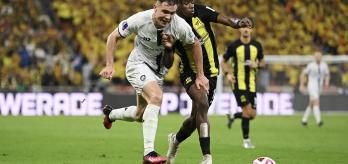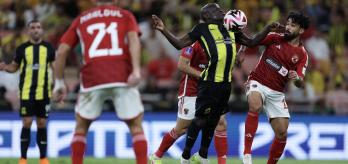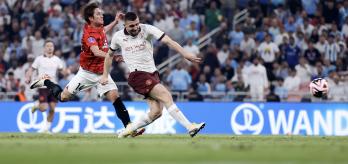Our Technical Study Group have attended all games throughout this competition in Jeddah and here, we highlight some key principles of City’s game when in and out of possession that could influence the outcome of what promises to be an intriguing final.
In possession
In their semi-final, City dominated the ball heavily with 69% possession compared to Urawa Reds’ 22.8% (8.2% in contest). With their opponents spending 44.5% of their out-of-possession time in a low block, City had to be creative to find ways to break this structure down.
A key and crucial component of City’s ability to break down the low block was their capacity to create and find spaces between the lines of Urawa Reds compact shape. Consistent player movement, decoy runs to move opposition defenders and committing attacking players into spaces where they were not expected to be, helped to isolate and overload the AFC champions’ defenders and distort their defensive structure. By pushing their defenders into midfield territory and midfielders into forward territory, it became more difficult for Urawa Reds to manage defensive responsibilities as City attacked relentlessly and with great variety.
This use of advancing players into unexpected areas is evidenced in the graphic below, where we see how often (and how many) City players offered to receive in behind Urawa Reds’ defensive line. Despite having three more advanced midfielders ahead of him, centre midfielder Mateo Kovačić (8) made 29 offers to receive in behind, making him the second-highest ranked player in the game for this action. Centre-back John Stones (5) (who operates in midfield when City are in possession) made eight offers to receive in behind, while left-sided defender Nathan Ake (6) also became an overload player high up the pitch, with six offers to receive in behind. Because Urawa Reds defenders were already occupied by City’s forward and midfield players, advancing defenders created overloads and were difficult to manage.
When we look at the total number of offers to receive in behind by game in this tournament, City’s semi-final performance ranked first, registering 144 offers in behind. In addition, the English side received the ball 22 times in behind the Urawa Reds defence. This is seven times more than any other team has managed in a single match in the competition to date (14 outside the opposition team shape, eight inside the opposition team shape).
It is clear this method of overloading opposition defensive lines is a core attacking principle for Pep Guardiola’s team and they are patient and relentless in their pursuit of opportunities to break lines. Not only do they have players that create movements to open spaces, but they also have players who can see the opportunities to execute line-breaking passes into spaces where they know other players ahead of them will run.
This City team thrive on space, and they have the capacity to see it and exploit it in many ways, regardless of the defensive state of their opponent. This makes them a very potent attacking threat and difficult to contain.
As we see in clip 1 below, City use a variety of methods to create overloads on opposition lines. Wide players stay wide in order to separate opposition defenders from their defensive block, creating gaps that City’s midfielders and forwards can exploit. The Sky Blues’ defenders underlap and make line-breaking runs from deep when defenders ahead of them are already occupied, making it extremely difficult, chaotic and tiring for opposition defenders.
In clip 2, we see an example of City’s build-up from the back, with a stunning line-breaking pass that releases Matheus Nunes (27) in behind (after making a very clever diagonal run) before Bernardo Silva (20) scores from the rebound.
Out of possession
Manchester City like to dominate the ball, illustrated by the 69% possession they acquired in their semi-final. When they lose the ball, they want to win it back as quickly as possible and because they commit so many players forward to their attacks, they have good numbers and presence for quick counter-pressing and/or high pressing. Against Urawa Reds, the Sky Blues spent 25.7% of their out-of-possession time in the high block/high press phases, which, as a proportion, is over 10% higher than any other team registered in a single match so far this competition.
City are not afraid to take defensive risks and it is notable how Guardiola consistently recruits defenders who can run at high speeds. He trusts his players to defend 1v1 and to recover quickly from advanced positions. The athletic ability of defenders to perform high speed recovery runs to negate the threat of the counter-attack is reinforced by right-back Kyle Walker (2) clocking the second highest top speed in the match at 33.5kph. Only Nunes registered a higher speed (34.9 kph).
An example of high-speed recovery runs by City defenders can be seen in clip 3 below. When City lose the ball following an attacking corner sequence, their defensive players recover with great pace meaning they are not outrun by counter-attacking opposition players.
In clip 4, we see how City are content for their defenders to be in 1v1 situations, should they lose the ball. In this example, when the ball is transitioned and played in behind City’s defensive line, Walker has the pace to not only recover from behind the attacking player but to pass him to win the ball and regain possession.
Goalkeeper: Ederson
During their semi-final against Urawa Reds, Manchester City dominated the ball for long spells and goalkeeper Ederson is a key player in this team when they are in possession. The variety and quality in his distribution of the ball are important factors in how Guardiola’s side build their play.
According to Pascal Zuberbühler, “Ederson is one of the best goalkeepers at playing out from the back. He is very comfortable with the ball at his feet, and he can play the ball in many different ways, depending on the situation. He can play short, can clip balls into players and can play longer passes to find players in space and plays into space where he knows players will run. He is an important in-possession player in this team.”
FIFA’s Goalkeeping Expert Group developed their own distribution framework to categorise a goalkeeper’s passes. The framework breaks goalkeeper passes down into five types:
In the game versus Urawa Reds, Ederson completed 43 of his 48 passes. Sorting these 48 passes according to the framework’s distribution types reiterates the Brazilian’s ability to initiate and be part of Manchester City’s build-up play:
-
Distribution type “Around”: 37
-
Distribution type “Into”: 4
-
Distribution type “Onto”: 2
-
Distribution type “Through”: 4
-
Distribution type “Other”: 1
In clip 5 below, we see how Ederson makes the first line-breaking pass in a Manchester City attacking sequence that results in a goal being scored.
However, a goalkeeper’s ability to prevent goals being scored is always a priority too. Maintaining concentration, particularly in games where their team is dominating the ball, is important and Ederson makes big interventions in big moments.
Zuberbühler continues, “He is also a very good shot-stopper and had to make two important interventions against Urawa Reds in the semi-final. He is aggressive in 1v1s and dominates his area on high balls. He is confident and he gives the defenders around him confidence also.”
In clip 6 below, we see a great example of Ederson’s aggressive and imposing presence in a 1v1 situation when his defensive line is breached. He advances without hesitation or fear before making an important intervention.
Manchester City take on Fluminense in the FIFA Club World Cup Saudi Arabia 2023™ final on Friday 22nd December in the King Abdullah Sports City Stadium in Jeddah, with a 21:00 kick-off (local time) and will be streamed live on FIFA+.











